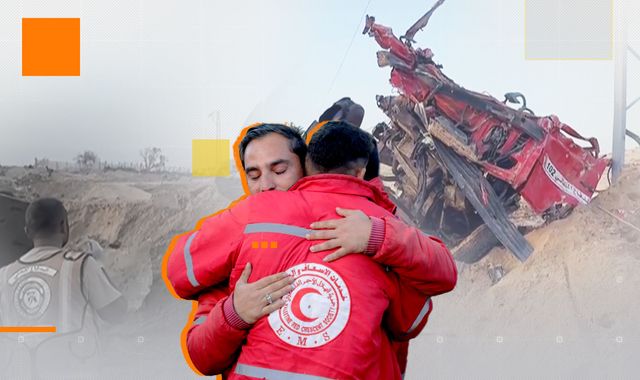
On Sunday, a mass grave containing the bodies of 15 first responders was unearthed in Gaza. Sky News investigates how their final moments unfolded.
The group had disappeared during a rescue mission one week earlier.
An ambulance belonging to the Palestine Red Crescent Society (PRCS) was on a rescue mission in the early hours of 23 March when it called for help, the NGO says, claiming it was under attack by Israeli forces.
Three more ambulances were dispatched to assist them, along with a crew from the public sector organisation Civil Defence, but contact was soon lost with the group.
Satellite imagery shows the area on 26 March, three days after they went missing. Tyre tracks are visible, as are groundworks likely created by military vehicles.
The IDF says that its troops fired on the ambulances because they had not coordinated their movements with the military, and that their headlights and emergency signals were turned off.
Speaking to Sky News, however, the director of ambulance and emergency services at PRCS Mohammed Abu Mosahba said that coordination was not required because they were not inside an evacuation zone.
"[The first ambulance] moved into the area without coordination because it was a safe area and does not require coordination," he said.
The map below shows the location of the attack, in yellow. In red are the areas that the IDF had marked as evacuation zones in the days prior to the attack. In orange is a new evacuation order issued on the day of the attack, which includes the attack location.
This evacuation order was first posted online by the IDF's Arabic spokesman at 8.31am local time that day, around four hours after the incident began and almost an hour after PRCS first publicly said it had lost contact with the crew.
Abu Mosahba says that after the first ambulance came under attack, PRCS did request coordination for the other three ambulances.
Dr Mohammed Al Mughir, director of logistics at Civil Defence, also says that coordination was not required to move in the area until the evacuation order was issued, which he says was "more than three hours after our colleagues were killed".
He further disputes the IDF's claim that the vehicles had their headlights, sirens and emergency lights switched off.
"All vehicles had light signals, phosphorescent markings and features indicating that they were emergency vehicles," he says.
The lights from one of the ambulances were later discovered lying on top of the mass grave, marking its location.
Partially buried alongside the bodies were all four ambulances, as well as a fire engine and a UN vehicle.
A military weapons expert told Sky News that at least one of the vehicles visible in the footage has "certainly been crushed".
When Sky News asked the IDF why the vehicles were crushed and the bodies buried, it said the incident was being investigated.
In footage taken by the UN, aid workers can be seen digging dead bodies out of sand piles and placing them in white bags to be transferred to the mortuary.
In an updated statement, the IDF told Sky News that the bodies were deliberately buried in sand to preserve them because they couldn't allow the UN access to recover the dead for a number of days due to operational activity. They also say they gave the UN the location of the grave.
This hasn't yet been confirmed by the UN.
Attacks on aid workers are growing more frequent
The discovery of the mass grave comes as aid organisations reconsider their position in Gaza amid a rise in attacks in the last few weeks.
At least 29 aid workers were killed or injured in the two weeks to 27 March, the highest rate of casualties in almost a year.
At least 336 aid workers have been killed in Gaza since the war began, according to the NGO Humanitarian Outcomes, which provides data on aid worker security to humanitarian agencies and governments.
The data does not include the deaths of people working for public-sector organisations, such as Civil Defence.
Meriah-Jo Breckenridge, a research analyst at Humanitarian Outcomes, says there has been a "definite uptick" in attacks on aid workers since the ceasefire broke down on 18 March.
On 19 March, a guest house belonging to the UN's Office for Project Services (UNOPS) was attacked, killing a Bulgarian staff member and injuring six other international workers.
The picture below shows the damage sustained by the building, with a large hole in one wall.
The UN says the building was fired on by an Israeli tank, an allegation that the Israeli government denies.
UNOPS chief Jorge Moreira da Silva said that Israel knew the location of the building and who was working there.
"This was not an accident," he said.
That attack came just one day after an airstrike on a nearby residential building killed an employee of medical charity Medicins Sans Frontiers (MSF).
"It's impossible for us to be able to operate in such conditions, when we put everybody at risk in an environment where the de-confliction is not working any more," said MSF head of mission Amanda Bazerolle.
Deconfliction is when aid organisations in Gaza voluntarily tell the IDF their locations to reduce the risk of accidentally being attacked.
Tom Fletcher, under-secretary general for the UN's Office for the Coordination of Humanitarian Affairs (OCHA), says that agencies are not able to work with Israel on protecting their staff as successfully as before.
"It wasn't always happening in the past, but it certainly isn't now," said Mr Fletcher in an interview with Sky News' Yalda Hakim.
Aid locations submitted to IDF
On 24 March, an office belonging to the International Committee of the Red Cross (ICRC) in Rafah was hit.
Footage taken in the immediate aftermath shows plumes of smoke billowing from the side of the building, which has a Red Cross flag clearly displayed on its roof.
The aid group said the structure was damaged by an explosive projectile. No one was killed or injured in the attack.
The IDF admitted responsibility, saying its forces had incorrectly identified a threat. They added that the building's ownership was "unknown to the force at the time of the shooting".
"There is basically not a single international aid organisation site, guest house, office or distribution point that has not been submitted with GPS coordinates to the IDF for probably the last year," says a senior aid worker who recently left Gaza.
"All movements are [deconflicted] and submitted for green lights."
On 25 March, the UN announced it had taken the "difficult decision" to remove around one third of its international staff from Gaza.
Olga Cherevko, a Gaza-based spokesperson for OCHA, says the decision was partly because of the UN has little aid to distribute, owing to a weeks-long Israeli blockade, but also "the lack of protection from Israeli authorities... in the sense that attacks against humanitarian workers have continued".
Director of the Palestinian NGOs Network Amjad Shawa criticised the UN's decision. "It's not just about aid delivery and distribution - they are our international protection and eye-witnesses," he said.
"It's very important for us to keep them here."
Olive Enokido-Lineham, OSINT producer, contributed reporting.
Watch Yalda Hakim's full interview with the UN's Tom Fletcher on The World with Yalda Hakim at 9pm on Sky News.
The Data and Forensics team is a multi-skilled unit dedicated to providing transparent journalism from Sky News. We gather, analyse and visualise data to tell data-driven stories. We combine traditional reporting skills with advanced analysis of satellite images, social media and other open-source information. Through multimedia storytelling we aim to better explain the world while also showing how our journalism is done.

(c) Sky News 2025: Gaza ambulance 'crushed' by IDF as aid attacks increase

 Trump's tariffs are about something more than economics: power
Trump's tariffs are about something more than economics: power
 Donald Trump announces sweeping global trade tariffs - including 10% on UK imports
Donald Trump announces sweeping global trade tariffs - including 10% on UK imports
 'No justification': World leaders react to Trump's tariff announcement
'No justification': World leaders react to Trump's tariff announcement